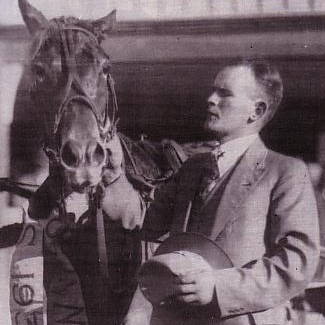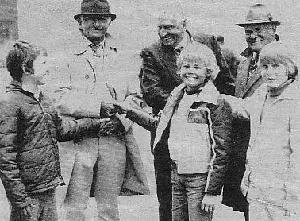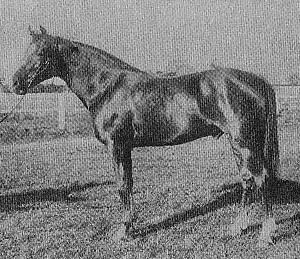| PEOPLE |
YEAR: 1998
 |
| Colin McLaughlin with Silver De Oro after the 1931 Sapling Stakes |
Colin McLaughlin has never been one to complain. When the golden run by the carriers of the Royal Stewart tartan were over, Colin enjoyed his racing no less. When moderates Dainty Dish and Meadow Pam carried the flag in place of Manaroa, Allakasam, Royal Ascot, Nimble Yankee and Manawaru - who between them won 75 races in NZ - Colin didn't rush to recall how racing used to be.
But he complained to me. "I've never stopped working, but in the last month I haven't done a thing. I haven't felt like it. I've had a fairly big operation. I'm 80 in July. I hope I get there.
Colin is not as fit and well as he would like to be. He put great discomfort behind him on the day of the Hororata trots so he could see Rosy Score race at Ashburton. Physical problems have not diminished Colin's alert mind, nor his ability to succinctly give his opinion on any matter in the harness racing industry.
Two events this season, quite insignificant in themselves, have disclosed the long arm of Colin's estate in harness racing. The first was the death of Allakasam, the daughter of Fallacy and Sedate who won the McLaughlins 18 races, including the 1967 Auckland Cup, the Hannon Memorial, the New Brighton Cup and the Easter Cup. And the second was the accomplishment of exhibiting the best-presented colt - by Kanturk from Morose - at the yearling sale conducted by Pyne Gould Guinnes in January and the runner-up, one by Preux Chevalier from Alleviate.
But Colin's involvement in racing was mobile long before Allakasam. He was the strapper for Silver De Oro, winner of the Sapling Stakes in 1931, and to Blair Athol, a good Rey De Oro horse who went on to run third in Lucky Jack's NZ Cup when trained by Dick Humphreys. In 1932 he had his first horse, Llewellyn's Pride. A son of Llewellyn, Llewellyn's Pride won his first race at Motukara in 1934. Colin said he paid more than £100 in winning the Wairewa Trot. He was 16/17 in the betting, but the Year Book of the day recorded favouritism but not dividends.
At the time of this success for the young man and for a further seven years, the family farmed at Halswell, on ground leased by the Travis Cancer Research Company. In 1939, when the lease expired, Colin moved to Mount Hutt. The same year, Colin moved in the direction that within two or three generations was going to yield remarkable results on the racetracks of New Zealand and Australia.
"I was able to lease Straight from Eugene McDermott's father. She was a nice pacer, by Jack Potts. She only won the one race. That was in 1939 when the war broke out. I was told she was mad when I leased her but I liked her and later bought the freehold of her. That was the taprootof this family. The best thing I ever did in my life was taking Straight to be mated with Young Bob. I was looking for Globe Derby blood. Young Bob was by Robert Derby, by Springfield Globe, who was by Globe Derby."
Young Bob and Straight gave him Sedate, who produced the grand racemare Allakasam, and two special broodmares, Morsel (by Fallacy) and Flying Mile (by Flying Song). The best of Allakasam's progeny were Allspice (by Estes Minbar) who won eight races, and Jaunty Hanover (by Jersey Hanover) whose eight wins included the Methven Cup and the Queen's Birthday Stakes. She is also the dam of Colarno (by Locarno), who on March 11 gave Wellington OTB committeeman Ron Stechman his first success as a trainer.
The winner of four races, Morsel left Nimble Yankee, the winner of 11 races including the 1977 Pan Am Mile and Royal Ascot, whose crowning achievement was winning the Auckland Cup; his placings were in such events as three Derbies, the Miracle Mile, Inter-Dominion heats and an Inter-Dominion Grand Final. Morsel also left Morose, the dam of Colin's latest racing interest, Rosy Score.
Flying Mile left Manawaru and Manaroa, two outstanding pacers sired by Prince Charming. Like Royal Ascot, Manaroa won 18 races, but he picked up the greater part of his earnings from placings in such feature races as the Inter-Dominion Grand Final, the Auckland and NZ Cups and the Miracle Mile. "I sent Flying Mile to Morano because his staying ability appealed to me. Manaroa and Morano were two of a kind; they both had the same failing of being able to begin," said Colin.
Manawaru and Royal Ascot were by Prince Charming, a son of Springfield Globe who won a few races for Mr E E Johnson of Irwell. "He was out of a mare I used to race and he had a lovely disposition. It was the Globe Derby blood I wanted. I thought I'd get him for £100, but I was able to buy him for 70 quineas," he said. "I just did my own mares, and a few for some mates. There wasn't really a mug amongst them. The point about all of mine was that I didn't has to put a boot on them. Where they got their good gait from I've never worked out; it might have been through Lawn Derby...he was poetry in motion."
Sitting back in the sun, totally impatient with his inactivity, Colin reflected on some other aspects of his harness racing world..."I'm disappointed with the results I've had to high-bred American stallions. I've been to seven and the results have been minimal...I had faith in Regal Yankee. He gave me Nimble Yankee and Jaunty Hanover and they both measured up...I had a soft spot for Manaroa. If they had had three mile races he would have won them all. You just had to wait until he got his legs going...I've never missed a Cup since 1923, when Great Hope won...I mucked around; I still maintain they were half-trained horses.
The death occurred early in February 1998 of Colin McLaughlin.
Credit: Mike Grainger writing in HRWeekly 22Mar89
YEAR: 1931
STRAIGHT - Mystery Mare
Colin McLaughlin was a man who did things his way. So there is mystery how a mare he bought as a young man in Ladbrooks(where his father Andy bred trotters) and did not produce her first winner until she was 17, led McLaughlin on a magic racing journey. The stream of unfashionably bred top class horses from one owner/trainer in a relatively short time is un-equalled and in these days of mass production will probably remain that way.
The first mare was Straight and her trip toward the limelight really began when McLaughlin, by then battling to make a go of farming in Mt Hutt, sent her to Young Bob, a Methven based stallion. The result, Sedate, won four for him and when she went to stud, her first three foals, Morsel, Flying Mile and Allakasam began a stunning run of form. Allakasam won an incredible seven Cup races including the Auckland, Easter and New Brighton editions. Flying Mile left the famous 'ugly duckling' Manaroa, one of the real characters of harness racing whose NZ Cup run was so phenomenal and then Manawaru with her first two foals. Morsel left the Auckland Cup winner, Royal Ascot.
McLaughlin had made the outwardly strange decision to breed his own stallion to his mares and bought Prince Charming for the purpose. Like Young Bob he was a Globe Derby line horse and the unusual double cross results were simply amazing.
Then, like a tap turning off, the Straight tribe wilted then virtually disappeared. There were winners of course and one or two good ones because Colin bred a lot of horses. Allakasam left Jaunty Hanover and Allspice and Morsel left Nimble Yankee and Remorse. Because he had so many mares Colin tended to mix visits to top studs with cheaper 'Hail Mary' stallions who didn't make the grade. The new generation of American blood did not seem to click and the blood thinned.
Then, in the mid 1980s, an unfashionably bred horse called Borana became the longest odds winner in the history of the NZ Cup for Peter Jones. Straight was his fourth dam. The family had finally won the Cup. These things happen in breeding but not often however does a back country farmer who went to Ellesmere instead of the U.S. to buy a stallionachiev so much with the results.
Credit: David McCarthy writing in Harnessed June 2016
YEAR: 1973
Mount Hutt owner, trainer & driver Colin (CJ) McLaughlin had three starters in the Cup. Royal Ascot, part owned and driven by Felix (FE) Newfield finished best in 5th place, Manawaru driven by Alan (AM) Harrison was 10th and Manaroa Colin McLaughlin was second last in 13th place.
YEAR: 1916
REFLECTION - Mystery Mare
In less than a decade the Reflection tribe through her daughter, Great Burton, a trotter of moderate ability, produced some astonishing performers virtually from nowhere. Unlike a lot of such overnight sensations this breed just went on, as the deeds of Elsu and a host of others testify. But it's beginnings seem to be almost too mundane to be true.
Michael McTeigue, who combined training with employment of the Islington Works, raced both Reflection foals Great Burton(2 wins) and Real Burton. Almost out of the blue those two really rocked the records when their respective foals, Burt Scott and Real Scott hit the tracks. McTeigue sold Burt Scott to Vis Alborn after an indifferent career start. Alborn won 10 of his first 12 starts with Burt Scott the following season, a new record for wins in one term. He was also the leading stake earner beating several famous names. These days he would have been a Pacer of the Year in virtually one season of racing!
Real Burton's foal, Real Scott,(Noble Scott) became something of a sensation in a similar style a few years later graduating to NZ Cup class from Noel Berkett's stable in one season(10 wins). That was extraordinarily difficult under the handicapping system as then operated where a horse went up a class after every win an sometimes even if second. No freebies until you got to free-for-all class.
Great Burton also left the stallion Scottish Star, the high class mare Zenith and Roydon Star ancestress of several top liners including Tobias, Take Care and Pocket Me. Zenith was prolific and it is to her Elsu traced along with stars like Tintin In America and De Lovely.
Two interesting asides, Great Burton was bred from largely by Ernest Johnson of Ellesmere, a breeder with an eye who had sold Prince Charming to Colin McLaughlin. Dick Monk carried the Great Burton line on with the Zenover branch. And from the somewhat mysterious Australian bred Reflection breed also came Silk Stockings the dam of Snowflake and other interesting skewbald pacers. Skewbald? Mmmm...that Reflection outfit was certainly different!
Credit: David McCarthy writing in Harnessed June 2016
YEAR: 1979
 |
Every boys dream...to meet a genuine war hero. And it is twice the pleasure for Gary Argyle, Simon Philip and Campbell Lochhead as they shake hands with two Victoria Cross winners, Charles Upham (VC and bar) and Jack Hinton, seen here with Mid-Canterbury trotting identity Colin McLaughlin (right) at the Ashburton races the other day. Mr Upham owns the broodmare Lansdowne, named after his Parnassus, North Canterbury property, and Mr Hinton, from Auckland, races Special Fella in partnership.
NOTE: The road that runs through the Addington property from Whiteleigh Avenue to Wrights Road is named "Jack Hinton Drive" in recognition of Mr Hinton.
Credit: NZ Trotting Calendar 9Oct79
YEAR: 1903
 |
Bred in California in 1903 Harold Dillon was imported as a yearling by Mr E T Le Lievre of Akaroa who played a major part in the development of the standardbred at that time. What Mr Le Lievre's reactions were when he first saw his new purchase cannot be guessed at but Harold Dillon turned out to be a very small horse and he never grew a great deal, being little more than a pony until the day he died.
Tried as a racehorse Harold Dillon was not a success but his breeding future received a boost when a member of his first small crop (he was used at the stud before he was 2 years old) won the Futurity Stakes at the Addington Easter meeting of 1909 which was an important race in it's time. This was Dillon Bell who reached the best classes, and another to do well from an early crop was Moa Bell who also won a number of races.
Harold Dillon had mixed patronage early on but once he was transferred to the Santa Rosa Stud at Halswell near Christchurch under a master horseman in Bob McMillan his stocks received a boost. Like many sires some of his stock acquired doubtful reputations which for a time threatened his own career but in the end his progeny were so successful on the track that he downed the critics and became a great sire.
Harold Dillon was leading sire for five seasons from 1916 until 1921 taking over from Rothschild and conceding leadership to Logan Pointer though he was second and third to that sire for a number of years.He produced 182 individual winners which was an excellent record for the day. His best one was the brilliant Author Dillon the Robalan of his time whose record of 18 wins and 14 placings would have been much better but for the ridiculous handicapping of the day which saw him giving away long starts to good fields. He won three NZ Free-For-Alls and was virtually unbeatable in these types of races. Like all the Harold Dillon breed he was as tough as old boots and raced from three to nine years for his record. He was a top juvenile pacer as well and was a surprising success as a sire, his mares going particularly well, producing among others Marlene (NZ Cup), Indian Clipper and Knave of Diamonds. He himself sired among others Queen Auditor who won 13 races and produced the top mare of the 50s in White Angel.
Cello Sydney Wilkes, himself little more than a pony was another top winner for Harold Dillon and among his 11 wins was the feat of winning four races at the Cup meeting which only one other horse has done, this being Cardigan Bay. Adonis another stallion on the small side was perhaps the best pacer of them all and was also a successful sire featuring prominently in the Misfortune family. Waitaki Girl by Harold Dillon won 14 races and nearly $12,000 in stakes winning the feature race at the Canterbury Park Winter Meeting four years in succession. Some of the Harold Dillons were great mudlarks one being Sungod who reached Cup class and was placed in that event. Sungod was a sire of note himself and sired All Sunshine, an ancestress of Lunar Chance.
John Dillon was another top class pacer and quite the fastest beginner seen up to his time. He started in several Cups but was a better sprinter than a stayer. The late 'Dil' Edwards claimed that John Dillon once did a quarter in 28 seconds in training at Addington which was sensational in those days. Other Cup class performers by Harold Dillon were Antonio Oinaki (also a successful sire) Dolly Dillon and Lord Dillon.
As a broodmare sire Harold Dillon was also successful his daughters producing over 200 winners, though he was more successful with his male line than some imported sires. Two from Harold Dillon mares were Pot Luck and Parisienne winner and runner-up in the 1938 Inter-Dominion Championship. Dilworth was a national recordholder and Reporter a top class performer, Grace Dillon was the grandam of Roschana the dam of Cardinal Garrison. Highland Princess was the dam of the winners of 31 races. Eileen Dillon was the dam of Acuity (7 wins) who in turn produced Poranui and the champion Australian pacer Jackie Scott. Prolific was the dam of Manoeuvre who won eight races while Tatsy Dillon who herself won the Dunedin Cup is the founder of a successful family including Tatsydale and the good trotters Merrin and Ali Bey.
Connie Dillon was a great producer for the Benny family of Springston and included in her offspring or descendants are Gold Peg (9 wins) the grandam of the ill-fated Balcairn, Royal Fame (8 wins) Royal Counter (10 wins)and others. Sakatawea the dam of Star Classic belongs to this family. Another successful Harold Dillon mare was Flossie Dillon dam of Sonoma (Methven Cup), Tom Thumb (8 wins) and Pat Dillon ancestress of a champion trotting family including Waitaki Hanover of whom she was grandam. Protector, the sire of Nigel Craig has Harold Dillon blood through his 3rd dam Muriel Dillon.
At Santa Rosa where Harold Dillon stood for most of his career until his death in 1929 there are no horses now, just rows and rows of houses. The stud may have gone and Harold Dillon may have gone but his influence on our bloodstock cannot be erased nearly as easily.
-o0o-
David McCarthy writing in NZ Trotguide 18Nov76
We cannot let the stud career of Harold Dillon go without adding to his list a mare which we inadvertently missed at the time. This was Mirie Dillon who founded a line of fine winners for Colin McLaughlin of Mt Hutt. She was the grandam of Allakasam and ancestress of Royal Ascot. Adding further to his list was Sadie Dillon the dam of the 1923 Cup winner Great Hope.
Credit: NZ Trotguide 11Nov76